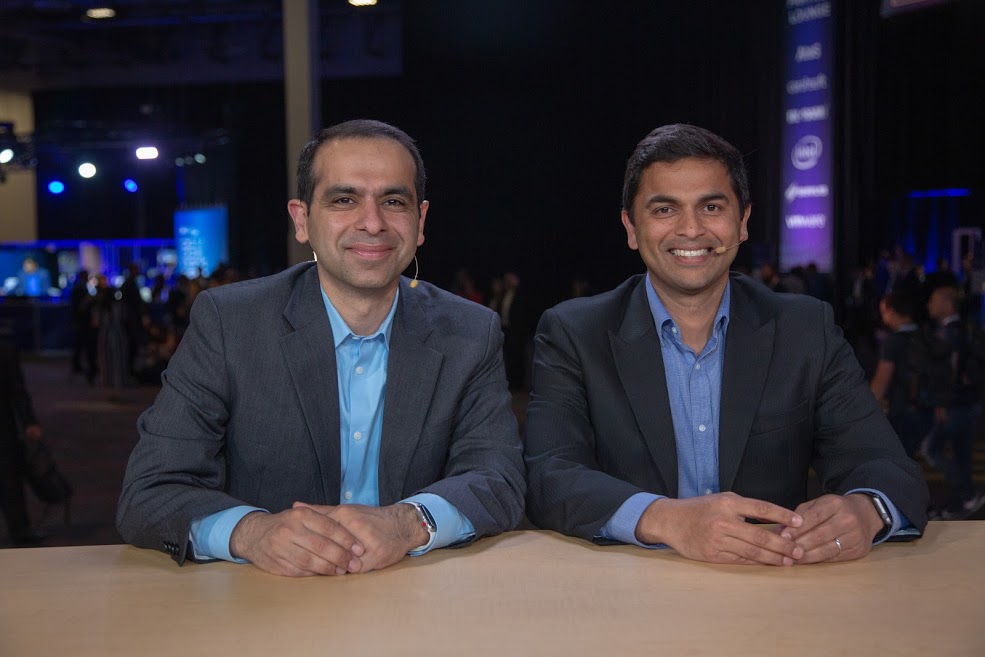 CLOUD
CLOUD
 CLOUD
CLOUD
 CLOUD
CLOUD
Not every cloud provider is equal. Some providers offer certain technical aspects or software programs that others don’t. They may work with different kinds of customers and incorporate different methods for helping those customers to stay efficient.
Dell EMC and VMware Inc. partner to give customers the latest upgrades in the cloud space. Both companies have discovered that collaborating and integrating cloud technology changes into their own operations help them to better understand customers’ needs and mindsets, according to Varun Chhabra (pictured, left), vice president of product marketing, Dell EMC cloud platform, at Dell Technologies Inc., and Muneyb Minhazuddin (pictured, right), vice president of product marketing — cloud, security and workspace solutions — at VMware Inc.
Chhabra and Minhazuddin spoke with Rebecca Knight (@knightrm) and Stu Miniman (@stu), co-hosts of theCUBE, SiliconANGLE Media’s mobile livestreaming studio, during the Dell Technologies World event in Las Vegas. They discussed what Dell can provide that other cloud providers can’t, the kinds of customers both companies are working with, and how VMware is looking to bring more cloud-based applications to customers (see the full interview with transcript here). (* Disclosure below.)
[Editor’s note: The following answers have been condensed for clarity.]
Miniman: Let’s talk about that public cloud. We know … VMware Cloud on AWS sent ripples through the industry — and the Google Cloud piece. So tell us what’s new. Anything different about the Microsoft piece when it becomes a public cloud, and how does that fit within relation to all the other clouds?
Minhazuddin: We think about customers’ choices first. You’ve got multiple cloud providers. Why are customers going towards the multicloud world? Because applications are going there. VMware’s strategy has been to say, “How do we empower customers with that choice?” Our AWS partnership is as strong as ever. We continue to innovate there. That was our first choice of platform. We have 4,000 cloud provider partners. They’re not small names. They include IBM. They’ve got Rackspace and some of the biggest cloud providers.
So, how do we take our stack and land it in as many public clouds as possible? We took the first step of IBM, then about 4,000 other cloud providers, be it Rackspace, Fujitsu or Hitachi. Then came Amazon, Amazon being the choice of destination for a lot of public clouds. Today, we further extend that with Microsoft, and with Google a few weeks ago, so this is about customers’ choices when they want the hybrid multicloud piece. It is app-driven. They want this in multiple places.
Knight: Can you talk about customers you’re working with? You don’t need to name names, but just how you are enabling those people to be more productive or more collaborative and to get their jobs done?
Chhabra: We have large banks that are standardizing their workloads on VMware today, as have many more organizations, and they’re looking for the flexibility to be able to move stuff to the cloud or move it back on-premises and not have to reformat. They don’t have to change their machine formats. This makes it easy.
They want the flexibility to be able to run applications in their bank branches in the cloud, but they don’t necessarily want to adopt a new machine format or a new standardized platform. We can now move workloads seamlessly to Azure by using vCenter or other tools that you’re familiar with today to be able to provision your workloads.
Miniman: There are lots of incentives to getting customers onto VMware, but often they’re N minus one, two or something like that. How do we manage and make sure that VMware is more cloud-like and up-to-date?
Chhabra: There are two ways to do that. One of them is, because the VMware and Dell EMC teams are working on engineering closely together, we’re going to have the latest version supported right out of the gate, so you have an update that’s going to work on your hardware or vice versa. That’s one level.
With VMware Cloud or Dell EMC, we’re also providing the ability to basically have hands-off management and have that infrastructure run in your data center or your edge locations, but at the same time not have to manage it. You leave that management to Dell Technologies and to VMware to be able to manage that solution for you. We’re bringing that public cloud experience to your on-premise locations as well.
Watch the complete video interview below, and be sure to check out more of SiliconANGLE’s and theCUBE’s coverage of the Dell Technologies World 2019 event. (* Disclosure: Dell Technologies Inc. sponsored this segment of theCUBE. Neither Dell nor other sponsors have editorial control over content on theCUBE or SiliconANGLE.)
Support our open free content by sharing and engaging with our content and community.
Where Technology Leaders Connect, Share Intelligence & Create Opportunities
SiliconANGLE Media is a recognized leader in digital media innovation serving innovative audiences and brands, bringing together cutting-edge technology, influential content, strategic insights and real-time audience engagement. As the parent company of SiliconANGLE, theCUBE Network, theCUBE Research, CUBE365, theCUBE AI and theCUBE SuperStudios — such as those established in Silicon Valley and the New York Stock Exchange (NYSE) — SiliconANGLE Media operates at the intersection of media, technology, and AI. .
Founded by tech visionaries John Furrier and Dave Vellante, SiliconANGLE Media has built a powerful ecosystem of industry-leading digital media brands, with a reach of 15+ million elite tech professionals. The company’s new, proprietary theCUBE AI Video cloud is breaking ground in audience interaction, leveraging theCUBEai.com neural network to help technology companies make data-driven decisions and stay at the forefront of industry conversations.